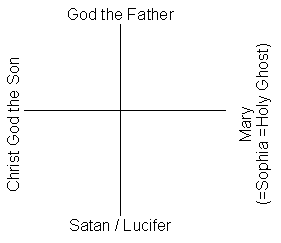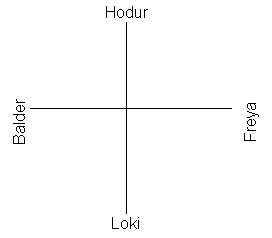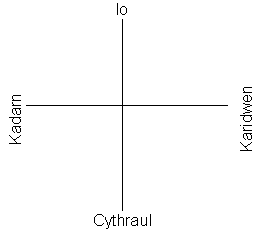| 
Comics can be read and interpreted on several levels. On the level of entertainment it only matters to let time pass in
a pleasurable, loose, way. The pictures are observed superficially and the accompanying text is partly swallowed. It needs to
be said that most comics can be enjoyed at this level only, often because of staggeringly ill-written stories. Yet some
white ravens can be found in the small world of comics. Marten Toonder is such an author and draftsman of stories who
invites both for entertainment as for a quest for the dungeons of Ollie B. Bommel's (and thus Toonder's) soul. In his work plenty
of symbolism (dream -, literary, and archetypal symbolism) is available.
Andreas isn't afraid of the heavier work, either. His stories are crammed with symbolism, in which feelings and problems in
disguised form represent Andreas' struggle with appearance and reality. It is filled with true emotion, straight from the heart.
La caverne du souvenir can be enjoyed on the level of entertainment and as a Celtic failytale with it's main theme the battle
between good and evil. The main actor in a theatrical company is killed by an adversary within the group. The perpetrator
represents evil. With this deed he tries to gain the powers of the dead man. His desire for power drags him down. He is killed
by falling rocks. In the twilight zone between life and death his soul seeks its destination. The epilogue is told by a druid
who points out in what way the soul should be taken to paradise.
The pictures experiment with odd compositions. The sphereful scenes are set in horizontal, vertical, or arced borders, seen from
different perspectives.
Diving deeper into the comic story the alert reader stumbles upon a great number of symbols. According to the Swiss psychologist
Carl Gustav Jung, who lived from 1875 to 1961, a symbol is a sensory representation of something surpassing the represented. A deeper
meaning is mentioned which is perhaps not understood by all, possibly sensed by many and only completely grasped by a handful of people.
In La caverne du souvenir the masses, who sense the symbolism somewhat, will have to do with the mythological story that accompanies the symbol,
for further explanation. In this case it is overly clear that Andreas is so fascinated by religion that he used the battle
between good (represented by God the father, Christ the son and Mary, the holy spirit) against evil (personified by Satan or Lucifer)
as feeding soil for this epic.
In doing so, he stumbled on primal images (so called archetypes), that originate from the collective unconscious. The Self,
the total of a personality, is such an archetype. This greater Self (many times greater than the ego, the small I or I-awareness of man)
expresses itself according to Jung in fourfolds in a cross form or in a circle (mandala) and is the expression of the totality of man.
The Shadow, an archetype as well, the so called evil (that is not really evil, but repressed) is symbolised in Christianity by
the devil and can be regarded as a supplement to the Christian trinity. The Holy Ghost (in Hebrew a feminine word) and
Mary collide; thus forming the following fourfold:

The fourfolds always express themselves in 3+1, 3 good and 1 evil or 3 conscious and 1 unconscious, or 3 ends of the cross are short
and 1 long, but also in 3 men and 1 woman, 3 young persons and 1 old. In the story of Andreas is Jean DeVille (Devil) the shadow, who
comes to consciousness. The treasure he craves represents the Self and this treasure can't be conquered by violence. They who want to
conquer the Self by violence will be destroyed by violence. And so Andreas makes it happen. Jean DeVille encounters himself as a dying old
man (page 23). He has died then already, but by this confrontation he realizes his Self through death. This way drawing and story telling
reminds one of the Bardo Thödol, the Tibetan book of the dead. Stumbling through the twilight zone of death Jean meets an old woman, the
archetype of Anima, leader of souls and intermediary between the I and the unconscious Self. Jean obviously hasn't made use of
the Anima (the female) in himself; as earthly being he had a pityful underdeveloped consciousness. The fourfolds in this story correspond
to those of Christian doctrine, as depicted above:
Stage: Norwegian

Reality: Celtic

Above all we are pointed to four cities, four wise men (pages 26, 27, 28) and the four blissful islands
(pages 55, 56). Kadern represents, like Balder and Christ, the Self in the form of the dying god/hero, sacrificing himself for gaining
consciousness (the treasure in the box). Man keeps looking, however, for that which is there internally already by nature, yet covered
by many veils: the Self.
(With thanks to Frans Gerritsen, member of the Interdisciplinaire Vereniging voor Analytische Psychologie.)
Literature:
Dr. R.J. van Helsdingen, C.G. Jung edition Kruseman 1983 Den Haag, 4th print
| |
